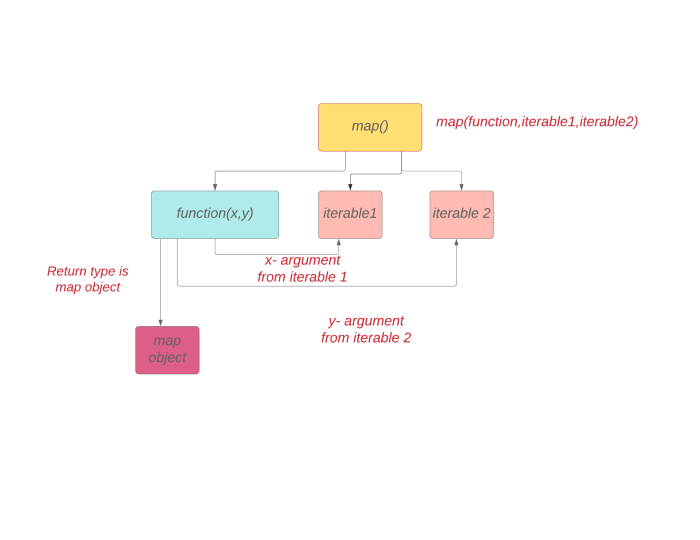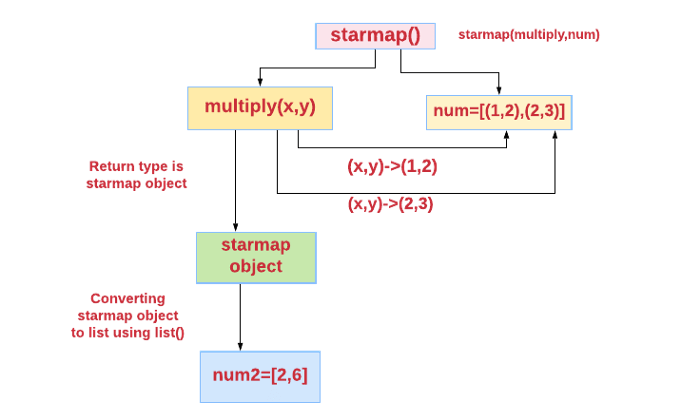Python map and starmap functions

python map function
python map function
map(function, iterable, ...)
Python map function
Return an iterator that applies function to every item of iterable, yielding the results. If additional iterable arguments are passed, function must take that many arguments and is applied to the items from all iterables in parallel. With multiple iterables, the iterator stops when the shortest iterable is exhausted. For cases where the function inputs are already arranged into argument tuples, see itertools.starmap()- The map() function is used to apply a function to each item in the iterable.
- We can also pass multiple iterables, but the function mentioned should also have that many arguments (e.g. two iterables means two arguments).
- If multiple iterables given are of different lengths, the map iterator stops when the shortest iterable is exhausted.
- The return type is a map object.
- map object is an iterator.
We can access the python map object, which is an iterator, in the following ways:
- We can convert the map object to sequence objects like a list using a list() constructor and like a tuple using a tuple() constructor.
- We can also iterate through the map object using a python for loop .
- We can access the element in the map object using the next() function as well.
Example 1: Applying a function to all items in one iterable using map()
- The
square()function is defined to return the square the numbers. - In the map function, we are passing the
square() functionandlist object. - The
square()function is applied to all items in the list object. - The return type is a map object.
- A map object is an iterator that contains the square of all items in the iterable (list object).
- Convert the map object to a list using a list() constructor.
def square(x):
return x*x
numbers = [1,2,3,4]
squares = map(square, numbers)
# Returns a map object
print(squares)
# output: <map object at 0x7f3c71350dd8>
print(type(squares))
# output: <class 'map'>
# converting map object to list() constructor
print(list(squares))
# output:
# [1, 4, 9, 16]
Example 2: Applying a lambda function to all items in one iterable using the map() function
numbers = [1,2,3,4]
squares = map(lambda x: x*x, numbers)
# Returns a map object
print(squares)
# output: <map object at 0x7f3c71350ef0>
print(type(squares))
# output: <class 'map'>
# converting map object to list() constructor.
list(squares)
# output:
# [1, 4, 9, 16]
# converting map object to tuple() constructor.
# need create new map object because previous map object (iterator) is at end
squares = map(lambda x: x*x, numbers)
tuple(squares)
# output:
# (1, 4, 9, 16)
Example 3: Applying a function to two iterables of the same length using the map() function
- Since two iterables are given, the function should contain two arguments.
- The
multiply(x, y)function will take the first argument x from the first iterable numbers1 and the second argument y from second iterable numbers2.
def multiply(x, y):
return x*y
numbers1 = [1,2,3,4]
numbers2 = [2,4,6,8]
squares = map(multiply, numbers1, numbers2)
# converting map object to list() constructor.
list(squares)
# output:
# [2, 8, 18, 32]
Example 4: Applying a function containing one argument to two iterables using the map() function
- This will raise a TypeError .
- For two iterables, the function should contain two arguments.
def multiply(x):
return x
numbers1 = [1,2,3,4]
numbers2 = [2,4,6,8]
squares = map(multiply, numbers1, numbers2)
# converting map object to list() constructor raise TypeError exception.
list(squares)
# output:
# TypeError: multiply() takes 1 positional argument but 2 were given
Example 5: Applying a function to more iterables of different lengths using the map() function
def multiply(x, y, z):
return x*y*z
num1 = [1, 2, 3, 4, 5, 6, 7, 8, 9, 10]
num2 = [2, 4]
num3 = [2, 3, 4, 5, 6]
s = map(multiply, num1, num2, num3)
list(s)
# output:
# [4, 24]
Example 6: Iterating through a map object using a for loop
def square(x):
return x*x
num1 = [1, 2, 3, 4]
square = map(square, num1)
for item in square:
print(item)
# output:
# 1
# 4
# 9
# 16
Example 7: Accessing elements in the map object using the next() function
- A map object is an iterator. So we can access the next element in the map object using the
next()function.
def square(x):
return x*x
numbers = [1, 2, 3, 4]
squares = map(square, numbers)
for item in squares:
print(item)
print(next(s))
print(next(s))
print(next(s))
print(next(s))
# output:
# 1
# 4
# 9
# 16
# numbers list has 4 items, so print(next(s)) raise error
print(next(s))
# output:
# Traceback (most recent call last):
# File "<stdin>", line 1, in <module>
# StopIteration
Example 8: Applying a built-in function to an iterable (string) using the map() function
colors = ['red', 'blue', 'green']
uppers = list(map(str.upper, colors))
list(uppers)
# output:
# ['RED', 'BLUE', 'GREEN']
python starmap function
python starmap function
itertools.starmap(function, iterable)
Python starmap function
Make an iterator that computes the function using arguments obtained from the iterable. Used instead of map() when argument parameters are already grouped in tuples from a single iterable (the data has been "pre-zipped").The difference between map()
and starmap()
parallels the distinction between function(a,b) and function(*c). Roughly equivalent to:
def starmap(function, iterable):
for args in iterable:
yield function(*args)
# starmap(pow, [(2,5), (3,2), (10,3)]) --> 32 9 1000
- First, we have to import the itertools module.
- The starmap method is supported by the itertools module only.
- starmap(function, iterable) → The function and iterable are passed to the starmap method.
- Items inside the iterable should also be iterable. Otherwise, it will raise a TypeError .
- The return type is an itertools.starmap object.
- The starmap object is an iterator.
We can access the starmap object, which is an iterator, in the following ways:
- We can convert the starmap object to sequence objects like a list using a list() constructor or a tuple using a tuple() constructor.
- We can also iterate through the map object using a for loop .
- We can access the element in the starmap object using the next() function as well.
Example 1: Applying a user-defined function to a list of tuples using starmap()
from itertools import starmap
numbers = [(1, 2), (2, 3)]
def multiply(x, y):
return x * y
starmap_object = starmap(multiply, numbers)
print(starmap_object)
# output:
# <itertools.starmap object at 0x7f3c71363278>
# Converting map object to list using list()
list(starmap_object)
# output:
# [2, 6]
Example 2: Applying pow() to a list of tuples using starmap()
import itertools
starmap_object = itertools.starmap(pow, [(0,2), (1,2), (2,2)])
print(starmap_object)
# output:
# <itertools.starmap object at 0x7f3c71363390>
# converting starmap object to list by using list() constructor.
list(starmap_object)
# output:
# [0, 1, 4]
using map():
map_object = map(pow, [0,1,2], [2,2,2])
list(map_object)
# output:
# [0, 1, 4]
Example 3: If elements inside the iterable are not iterable, it will raise a TypeError
import itertools
starmap_object = itertools.starmap(lambda x: x**2, [1,2,3])
list(starmap_object)
# output:
# Traceback (most recent call last):
# File "<stdin>", line 1, in <module>
# TypeError: 'int' object is not iterable
##### Example 4: Applying a lambda function to a list of tuples using starmap()
```python3
import itertools
starmap_object = itertools.starmap(lambda x,y: x+y, [(0,1), (1,2), (2,3)])
list(starmap_object)
# output:
# [1, 3, 5]
Example 5: Accessing items in the starmap object using a for loop
import itertools
starmap_object = itertools.starmap(lambda x, y: x + y, [(0, 1), (1, 2), (2, 3)])
for item in starmap_object:
print(item)
# output:
# 1
# 3
# 5
Example 6: Accessing items in the starmap object using the next() method
- A starmap object is an iterator. So we can access the next element in the map object using the
next()function.
import itertools
starmap_object = itertools.starmap(lambda x,y: x+y, [(0,1), (1,2), (2,3)])
print(next(starmap_object)) # output:1
print(next(starmap_object)) # output:3
print(next(starmap_object)) # output:5


















